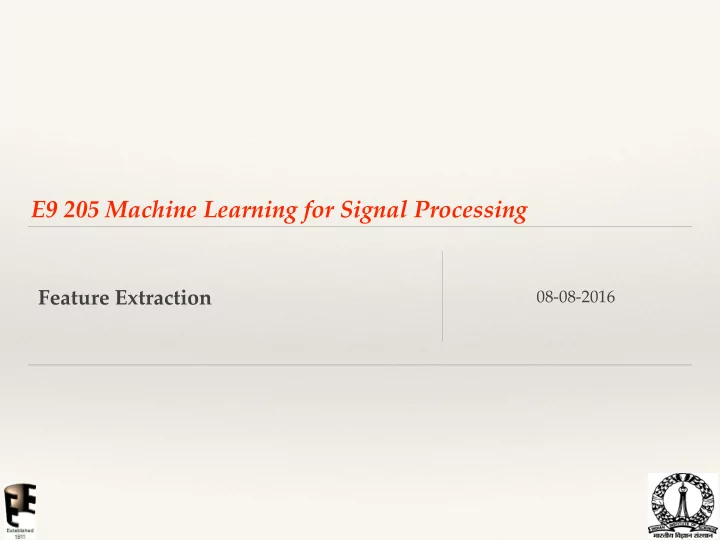

E9 205 Machine Learning for Signal Processing Feature Extraction 08-08-2016
Recap ❖ Real-world signals ❖ Patterns in signal ❖ Learning - uncovering the underlying patterns ❖ Roadmap of the course
Types of Learning Supervised Learning Reinforcement Methods Unsupervised Camstra, Vinciarelli, “Machine Learning for Audio, Image and Video Analysis” 2007.
Unsupervised Learning ❖ Data is presented without associated output targets ❖ Extracting structure from the data. ❖ Examples like clustering and segmentation. ❖ Concise description of the data - dimensionality reduction methods.
Reinforcement Learning ❖ Dynamic environment resulting in triplets - state/ action/reward. ❖ No optimal action for a given state ❖ Algorithm has to learn actions in a way such the expected reward is maximized over time. ❖ May also involve minimizing punishment. ❖ Reward/punishment could be delayed - learning based on past actions. Sutton, Barto, “Reinforcement Learning: An Introduction.” MIT Press, 1998.
Supervised Learning ❖ Training data is provided with along with target values (ground truth). ❖ Goal - to learn the mapping function from data to targets. ❖ Use the mapping function to predict unseen/test data samples. ❖ Two types based on the structure of the labels. ❖ Classification - discrete number of classes or categories. ❖ Regression - continuous output variables.
Supervised Learning http://www.astroml.org/sklearn_tutorial/auto_examples/plot_ML_flow_chart.html
Feature Extraction ❖ Feature Extraction ❖ Using measured data to build desirable values. ❖ Attributes of the data that are informative and non- redundant. ❖ Resilience to noise/artifacts. ❖ Facilitating subsequent learning algorithm.
Feature Extraction ❖ Representation Problem Cartesian Coordinates Polar Coordinates
Feature Extraction Scope for this course I. Feature Extraction in Speech and Audio signals. II. Feature Extraction Methods for Images. III. Brief Introduction to Feature Extraction in Text.
Speech and Audio ❖ Speech/Audio - 1D signals ❖ Generated by pressure variations producing regions of high pressure and low pressure. ❖ Travels through a medium of propagation (like air, water etc). ❖ Human sensory organ - eardrum. ❖ Converting pressure variations to electrical signals. ❖ Action mimicked by a microphone.
Sound waves in a computer ❖ Analog continuous signal from the microphone ❖ Discretized in time - sampling. ❖ Digitized in values - quantization. http://mlsp.cs.cmu.edu/courses/fall2014/lectures/slides/Class1.Introduction.pdf
Sampling ❖ Signals like speech/audio - analyzed in terms of sinusoids. ❖ Can be considered as a set of basis functions. ❖ Complex sinusoid - ❖ Signal expressed as weighted sum (integral) of sinusoids. ❖ Continuous Time Fourier Transform
Sampling ❖ Band limited signals ❖ Nyquist theorem - sampling frequency Oversampling Undersampling ❖ Speech signals ❖ maximum frequency ~ 4 - 8 kHz, typical sampling frequency - (8/16 kHz). http://mlsp.cs.cmu.edu/courses/fall2014/lectures/slides/Class1.Introduction.pdf
Quantization ❖ Storing real values using finite number of bits http://mlsp.cs.cmu.edu/courses/fall2014/lectures/slides/Class1.Introduction.pdf
Quantization ❖ Speech signal quantization
Short-term Fourier Transform
Why do we need time varying Fourier Transform ❖ When the signal properties change in time ❖ DFT will only capture the average spectral character ❖ Short-window analysis can indicate the change in spectrum.
Summary of STFT Properties
Narrowband versus Wideband ❖ Short windows - poor frequency resolution - wideband spectrogram ❖ Long windows - poor time resolution - narrowband spectrogram
Narrowband versus Wideband Dan Ellis, “STFT Tutorial”
Spectrogram of Real Sounds Dan Ellis, “STFT Tutorial”
Narrowband versus Wideband Dan Ellis, “STFT Tutorial”
Spectrogram in Matlab Dan Ellis, “STFT Tutorial”
Recommend
More recommend